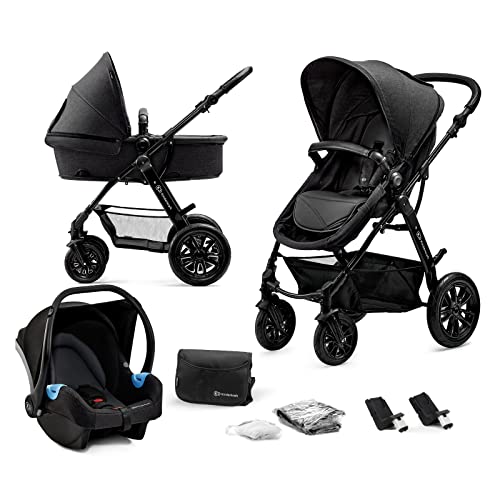Transitioning from Pram to Stroller: A Comprehensive Guide for Parents
Navigating the world of baby gear can be frustrating for new moms and dads, particularly when it comes to selecting in between prams and strollers. Both serve necessary functions, but they are created for different requirements and phases of a child's development. This short article aims to notify moms and dads about the shift from prams to strollers, laying out the advantages and considerations while supplying practical ideas.
Understanding Prams and Strollers
Before diving into their differences, it's vital to comprehend what constitutes a pram and a stroller.
Prams:
A pram, brief for perambulator, is usually created for babies as much as around six months old. It features a flat, padded sleeping area and is mainly intended for carrying very young children. Top Pram are designed for convenience and safety, as newborns require to lie flat to support their spine and organs.
Strollers:
Strollers, or pushchairs, are created for a little older children who can sit up unaided. They come in various styles and setups, from lightweight umbrella strollers to heavier-duty designs ideal for rough terrains. Strollers are more versatile and simpler to steer in crowded spaces, making them a popular choice for active households.
Advantages of Transitioning from Pram to Stroller
- Increased Mobility and Convenience
Strollers are usually lighter and more compact than prams, making them simpler to navigate through shops, public transportation, and crowded areas. Most strollers can fold quickly, enabling convenient storage. - Flexibility for Different Activities
Modern strollers typically include multiple setups and can accommodate different activities, including running, outdoor adventures, and shopping journeys. They can also adapt to fit children of different ages and weights. - Boosted Child Comfort and Safety
Lots of strollers now come geared up with sophisticated safety features, such as five-point harnesses and reclining seats, making sure that older babies and young children stay comfy and safe throughout outings. - Cost-efficient Solution
Rather than purchasing both a pram and a stroller, households can buy a high-quality stroller that satisfies the needs of their growing child, possibly saving money in the long run.
When to Make the Transition
The transition from a pram to a stroller normally happens when the kid reaches around six to seven months of age or when they can stay up unassisted. However, numerous factors can affect this transition, including:
- Child's Development: If the child shows indications of desiring to explore their surroundings, it might be time to switch to a stroller.
- Family Lifestyle: Active households may need a stroller earlier to accommodate outings and travel.
- Comfort: Observe the kid's comfort level. If they appear confined in a pram or are ending up being more active, it's time to consider a stroller.
Selecting the Right Stroller
Selecting the best stroller needs cautious consideration of numerous elements:
| Factor | Description |
|---|---|
| Safety Features | Try to find strong construction, reliable brakes, and harness systems. |
| Weight and Foldability | Select a light-weight stroller that is simple to fold and transfer. |
| Age Appropriateness | Guarantee the stroller is matched for your kid's age, weight, and height. |
| Maneuverability | Check how quickly the stroller relocations and turns, particularly in crowded spaces. |
| Storage Space | Think about the storage capacity underneath the stroller and the size when folded. |
| Adjustability | Search for strollers with adjustable features, such as seat recline and handle height. |
Frequently asked questions about Transitioning from Pram to Stroller
Q: Is it essential to switch to a stroller?A: While it's not obligatory, switching to a stroller typically offers more flexibility and ease for both moms and dad and child as they grow. Q: What features must I prioritize
in a stroller?A: Prioritize security functions, weight, foldability, and storage capability based upon your lifestyle and activities with your child. Q: Can I utilize a stroller for newborns?A: Some strollers can accommodate infant safety seat or
have flat reclining seats, making them suitable for
newborns. Always inspect the maker's guidelines. Q: How can I ensure my kid is comfy in a stroller?A: Look for strollers with padded seats, numerous recline positions, and adjustable leg rests to accommodate your kid's convenience. Q: What are the very best types of strollers available?A: Popular types consist of umbrella strollers, jogging strollers, travel system strollers, and convertible strollers, each dealing with differentrequirements. Tips for a Smooth Transition Test Out Different Models: Before dedicating to a purchase, physically test various strollers to see which one matches both you and your child best. Include Your Child:
If they are old enough, allow your
child to try various strollers to see which they find most comfortable. Read Reviews: Consider taking a look at online evaluations and recommendations from other parents to much better notify your choice
. Plan for Storage and Transport: Factor in how the stroller will fit into your car or home storage space to avoid future hassles.
- Assess Your Activities: Think about where and how you prepare to use the stroller-- metropolitan locations may require a different type compared to rural or off-road settings.
- Transitioning from a pram to a stroller is an important turning point in a kid's life and a substantial decision for parents. By understanding the distinctions and
benefits of each, parents can make informed choices that will support their household's lifestyle and their kid's development. Equipped with the best details, parents can with confidence browse this shift and
ensure that their kid is safe, comfortable, and prepared for all the adventures ahead.

